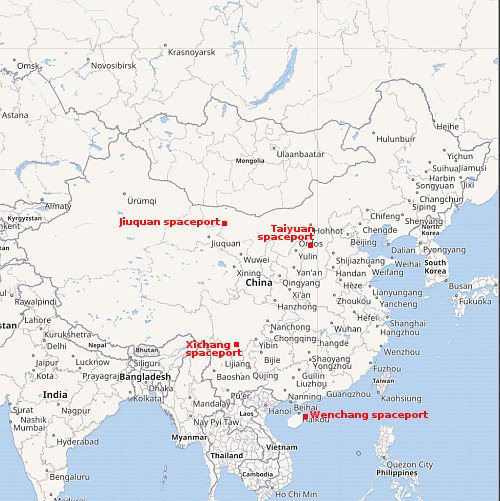Chinese pseudo-company Galactic Energy launches seven satellites

China’s spaceports
One of China’s pseudo-companies, Galactic Energy, yesterday successfully placed seven small satellites into orbit, using its Ceres-1 solid-fueled rocket that lifted off from China’s Jiuquan spaceport in the Gobi Desert.
Considering that a launch two days ago from the Taiyuan spaceport apparently dropped sections of its first stage near habitable areas, I though it worthwhile to post again the map to the right, showing which Chinese spaceports expose China’s inhabitants to risk.
It also appears that even the state-run press of China knows Galactic Energy really isn’t a privately owned commercial company, as it doesn’t even mention the company’s name in its news report at the link. While it gets investment capital and functions kind of like a private company, everything it does is supervised by the Chinese government, which can take full control of the company whenever it wants. Moreover, the technology of its solid-fueled rocket was derived entirely from military technology, which means the Chinese government supervised its development every step of the way.
The leaders in the 2023 launch race:
54 SpaceX
33 China
10 Russia
6 Rocket Lab
6 India
American private enterprise still leads China in successful launches 62 to 33, and the entire world combined 62 to 54, while SpaceX by itself is now tied the world (excluding American companies) 54 to 54.

China’s spaceports
One of China’s pseudo-companies, Galactic Energy, yesterday successfully placed seven small satellites into orbit, using its Ceres-1 solid-fueled rocket that lifted off from China’s Jiuquan spaceport in the Gobi Desert.
Considering that a launch two days ago from the Taiyuan spaceport apparently dropped sections of its first stage near habitable areas, I though it worthwhile to post again the map to the right, showing which Chinese spaceports expose China’s inhabitants to risk.
It also appears that even the state-run press of China knows Galactic Energy really isn’t a privately owned commercial company, as it doesn’t even mention the company’s name in its news report at the link. While it gets investment capital and functions kind of like a private company, everything it does is supervised by the Chinese government, which can take full control of the company whenever it wants. Moreover, the technology of its solid-fueled rocket was derived entirely from military technology, which means the Chinese government supervised its development every step of the way.
The leaders in the 2023 launch race:
54 SpaceX
33 China
10 Russia
6 Rocket Lab
6 India
American private enterprise still leads China in successful launches 62 to 33, and the entire world combined 62 to 54, while SpaceX by itself is now tied the world (excluding American companies) 54 to 54.

